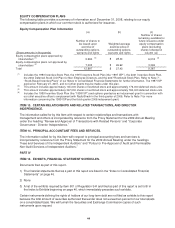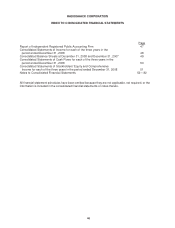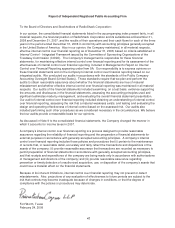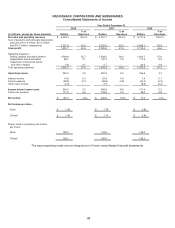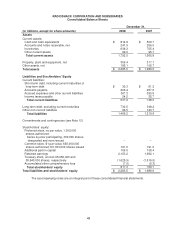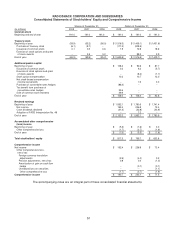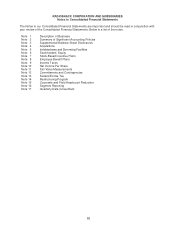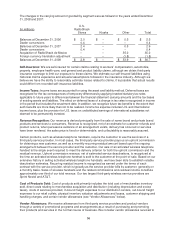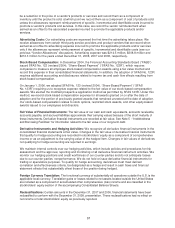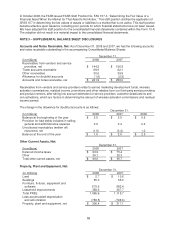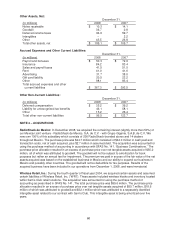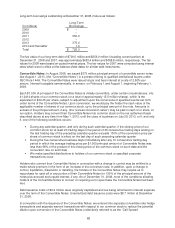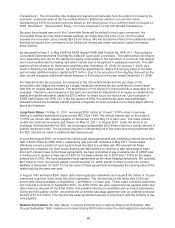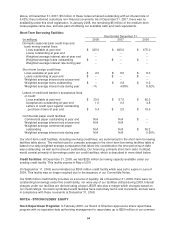Radio Shack 2008 Annual Report Download - page 61
Download and view the complete annual report
Please find page 61 of the 2008 Radio Shack annual report below. You can navigate through the pages in the report by either clicking on the pages listed below, or by using the keyword search tool below to find specific information within the annual report.International Operations: As of December 31, 2008, there were 200 company-operated stores under the
RadioShack brand, 14 dealers, and one distribution center in Mexico. Prior to December 2008, these
operations were overseen by a joint venture in which we were a slightly less than 50% minority owner with
Grupo Gigante, S.A.B. de C.V. In December 2008, we acquired 100% ownership of this joint venture. See
Note 4 - “Acquisitions” for more information. All of our 23 locations in Canada were closed by January 31,
2007.
Support Operations:
Our retail stores, along with our kiosks and dealer outlets, are supported by an established infrastructure.
Below are the major components of this support structure.
Distribution Centers - At December 31, 2008, we had four distribution centers shipping over 900
thousand cartons each month, on average, to our U.S. retail stores and dealer outlets. One of these
distribution centers also serves as a fulfillment center for our online customers. Additionally, we have a
distribution center that ships fixtures to our U.S. RadioShack company-operated stores. During the first
half of 2008, we closed our distribution center in Columbus, Ohio.
RadioShack Technology Services (“RSTS”) - Our management information system architecture is
composed of a distributed, online network of computers that links all stores, customer channels,
delivery locations, service centers, credit providers, distribution facilities and our home office into a
fully integrated system. Each store has its own server to support the point-of-sale (“POS”) system.
The majority of our U.S. RadioShack company-operated stores communicate through a broadband
network, which provides efficient access to customer support data. This design also allows store
management to track sales and inventory at the product or sales associate level. RSTS provides the
majority of our programming and systems analysis needs.
RadioShack Global Sourcing (“RSGS”) - RSGS serves our wide-ranging international import/export,
sourcing, evaluation, logistics and quality control needs. RSGS’s activities support our name brand and
private brand businesses.
Consumer Electronics Manufacturing - We operate two manufacturing facilities in the United States
and one overseas manufacturing operation in China. These three manufacturing facilities employed
approximately 1,900 employees as of December 31, 2008. We manufacture a variety of products,
primarily sold through our retail outlets, including telephony, antennas, wire and cable products, and a
variety of “hard-to-find” parts and accessories for consumer electronics products.
NOTE 2 - SUMMARY OF SIGNIFICANT ACCOUNTING POLICIES
Principles of Consolidation: The Consolidated Financial Statements include our accounts and our majority-
owned subsidiaries. Investments in 20% to 50% owned companies are accounted for using the equity
method. Significant intercompany transactions and accounts are eliminated in consolidation.
Segments: U.S. RadioShack company-operated stores and kiosks are our reportable segments based on
the criteria of Statement of Financial Accounting Standards (“SFAS”) No. 131, "Disclosures About
Segments of an Enterprise and Related Information." The accounting policies of the reportable segments
are the same as those described in the remainder of this note.
Use of Estimates: The preparation of financial statements in accordance with accounting principles
generally accepted in the United States requires us to make estimates and assumptions that affect the
reported amounts of assets and liabilities, related revenues and expenses, and the disclosure of gain and
loss contingencies at the date of the financial statements and during the periods presented. We base these
estimates on historical results and various other assumptions believed to be reasonable, all of which form the
basis for making estimates concerning the carrying values of assets and liabilities that are not readily
available from other sources. Actual results could differ materially from those estimates.
Cash and Cash Equivalents: Cash on hand in stores, deposits in banks and all highly liquid investments
with an original or remaining maturity of three months or less at the time of purchase are considered cash
and cash equivalents. We carry our cash equivalents at cost, which approximates fair value because of the
54


